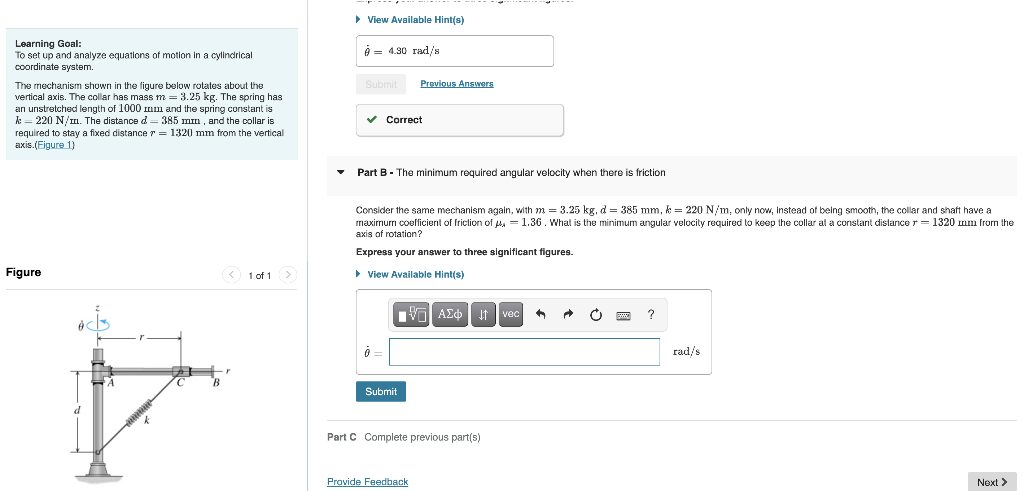Consider the same mechanism again, with m = 3.25 kg, d = 385 mm, k: = 220 N/m, only now, Instead of being smooth, the collar and shaft have a maxirmurm coefficient of friction of p. = 1.36. What is the minimum angular velocity required to keep the collar at a constant distance r= 1320 mm from the axis of rotation? Express your answer to three significant figures.
Consider the same mechanism again, with m = 3.25 kg, d = 385 mm, k: = 220 N/m, only now, Instead of being smooth, the collar and shaft have a maxirmurm coefficient of friction of p. = 1.36. What is the minimum angular velocity required to keep the collar at a constant distance r= 1320 mm from the axis of rotation? Express your answer to three significant figures.
Elements Of Electromagnetics
7th Edition
ISBN:9780190698614
Author:Sadiku, Matthew N. O.
Publisher:Sadiku, Matthew N. O.
ChapterMA: Math Assessment
Section: Chapter Questions
Problem 1.1MA
Related questions
Question

Transcribed Image Text:• View Available Hint(s)
Learning Goal:
To set up and analyze equations of motion in a cylindrical
coordinate system.
A = 4.30 rad/s
Submit
Previous Answers
The mechanism shown in the figure below rotates about the
vertical axis. The collar has mass
an unstretched length of 1000 mm and the spring constant is
k = 220 N/m. The distance d= 385 mm , and the collar is
required to stay a fixed distancer = 1320 mm from the vertical
axis.(Figure 1)
= 3.25 kg. The spring has
v Correct
Part B- The minimum required angular velocity when there is friction
Consider the same mechanism again, with m = 3.25 kg, d = 385 mm, k = 220 N/m, only now, instead of being smooth, the collar and shaft have a
maxirmurm coefficient of friction of p. = 1.36. What is the minimum angular velocity required to keep the collar at a constant distance r= 1320 mm from the
axis of rotation?
Express your answer to three significant figures.
Figure
1 of 1>
• View Available Hint(s)
η ΑΣφ
It vec
rad/s
Submit
d
Part C Complete previous part(s)
Provide Feedback
Next >
Expert Solution
This question has been solved!
Explore an expertly crafted, step-by-step solution for a thorough understanding of key concepts.
This is a popular solution!
Trending now
This is a popular solution!
Step by step
Solved in 2 steps with 2 images

Knowledge Booster
Learn more about
Need a deep-dive on the concept behind this application? Look no further. Learn more about this topic, mechanical-engineering and related others by exploring similar questions and additional content below.Recommended textbooks for you

Elements Of Electromagnetics
Mechanical Engineering
ISBN:
9780190698614
Author:
Sadiku, Matthew N. O.
Publisher:
Oxford University Press

Mechanics of Materials (10th Edition)
Mechanical Engineering
ISBN:
9780134319650
Author:
Russell C. Hibbeler
Publisher:
PEARSON

Thermodynamics: An Engineering Approach
Mechanical Engineering
ISBN:
9781259822674
Author:
Yunus A. Cengel Dr., Michael A. Boles
Publisher:
McGraw-Hill Education

Elements Of Electromagnetics
Mechanical Engineering
ISBN:
9780190698614
Author:
Sadiku, Matthew N. O.
Publisher:
Oxford University Press

Mechanics of Materials (10th Edition)
Mechanical Engineering
ISBN:
9780134319650
Author:
Russell C. Hibbeler
Publisher:
PEARSON

Thermodynamics: An Engineering Approach
Mechanical Engineering
ISBN:
9781259822674
Author:
Yunus A. Cengel Dr., Michael A. Boles
Publisher:
McGraw-Hill Education

Control Systems Engineering
Mechanical Engineering
ISBN:
9781118170519
Author:
Norman S. Nise
Publisher:
WILEY

Mechanics of Materials (MindTap Course List)
Mechanical Engineering
ISBN:
9781337093347
Author:
Barry J. Goodno, James M. Gere
Publisher:
Cengage Learning

Engineering Mechanics: Statics
Mechanical Engineering
ISBN:
9781118807330
Author:
James L. Meriam, L. G. Kraige, J. N. Bolton
Publisher:
WILEY